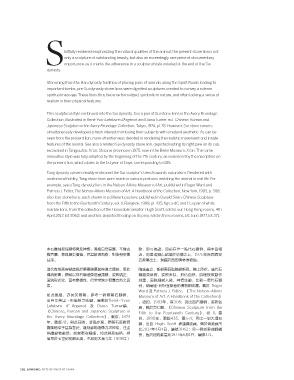Page 140 - Sotheby's Junkunc Collection March 2019
P. 140
killfully rendered emphasizing the natural qualities of the animal, the present stone lion is not
only a sculpture of outstanding beauty, but also an exceedingly rare piece of documentary
Simportance, as it marks the adherence to a sculptural style initiated at the end of the Sui
dynasty.
Stemming from the Han dynasty tradition of placing pairs of animals along the Spirit Roads leading to
important tombs, pre-Sui dynasty stone lions were dignified sculptures created to convey a solemn
spiritual message. These lions thus became formalized, symbolic in nature, and often lacking a sense of
realism in their physical features.
This sculptural style continued into the Sui dynasty. See a pair of Sui stone lions in the Avery Brundage
Collection, illustrated in René-Yvon Lefebvre d’Argencé and Diana Turner, ed., Chinese, Korean and
Japanese Sculpture in the Avery Brundage Collection, Tokyo, 1974, pl. 78. However, Sui stone carvers
simultaneously developed a fresh interest in imbuing their subjects with a natural aesthetic. As can be
seen from the present lion, more attention was devoted in rendering the realistic movement and innate
features of the animal. See also a related Sui dynasty stone lion, depicted resting its right paw on its cub,
excavated in Tangjiazhai, Xi’an, Shaanxi province in 1975, now in the Beilin Museum, Xi’an. The same
innovative style was fully adopted by the beginning of the 7th century, as evidenced by the inscription on
the present lion, which dates to the 1st year of Daye, corresponding to 605.
Tang dynasty carvers readily embraced the Sui sculptor’s trend towards naturalism. Rendered with
anatomical fidelity, Tang stone lions were made in various postures imitating the animal in real life. For
example, see a Tang dynasty lion, in the Nelson-Atkins Museum of Art, published in Roger Ward and
Patricia J. Fidler, The Nelson-Atkins Museum of Art. A Handbook of the Collection, New York, 1993, p. 308;
also four stone lions, each shown in a different posture, published in Osvald Sirén, Chinese Sculpture
from the Fifth to the Fourteenth Century, vol. II, Bangkok, 1998, pl. 435, figs a-dC and D; a pair of white
marble lions, from the collection of the Honorable Senator Hugh Scott, sold in our Hong Kong rooms, 4th
April 2017, lot 3062; and another, depicted feeding on its prey, sold in these rooms, 1st June 1977, lot 371.
本石雕捕捉瑞獅特徵及神態,風格自然寫實,不僅古 款,即可為證。目前存世一隋代石獅例,與本品相
雅秀麗,兼具歷史價值,見證新現風格,對後朝影響 近,刻畫瑞獅右足踏於幼獅之上,1975年陝西西安
甚深。 唐家寨出土,現藏於西安碑林博物館。
漢代有放置靈獸造像於重要陵墓前神道之傳統,受此 隋滅唐立,新朝藝匠取隋朝新風,錦上添花,唐代石
傳統影響,隋朝以前石獅造像莊嚴肅穆,姿態端正, 獅越見寫實,姿態多樣,形仿自然,肌理按照動作
面貌形式化,富有象徵性,但常常缺少寫實自然之因 刻畫,面貌細膩入微,神情生動。比較一唐代石獅
素。 例,納爾遜-阿特金斯藝術博物館收藏,載於 Roger
Ward 及 Patricia J. Fidler,《The Nelson-Atkins
如此風格,亦見於隋朝。參考一對隋朝石獅例, Museum of Art. A Handbook of the Collection》
出自艾弗里•布倫戴奇收藏,圖載於René-Yvon ,紐約,1993年,頁308;另比四石獅例,姿態各
Lefebvre d’Argencé 及 Diana Turner編, 異,載於喜仁龍,《Chinese Sculpture from the
《Chinese, Korean and Japanese Sculpture in Fifth to the Fourteenth Century》,卷 II,曼
the Avery Brundage Collection》,東京,1974 谷,1998年,圖版435,圖a-d;再比一對大理石
年,圖版78。與此同時,新風亦現,隋朝石匠對寫 獅,出自 Hugh Scott 參議員收藏,售於香港蘇富
實風格似乎甚為喜愛,雕刻動物造像力求神似,注重 比2017年4月4日,編號3062;另一例刻畫瑞獅捕
描繪動物動態,刻畫更為精細。如此創新風格,相 食,售於紐約蘇富比1977年6月1日,編號371。
信早於七世紀初期出現,本品刻大業元年(605年)
138 JUNKUNC: ARTS OF ANCIENT CHINA

